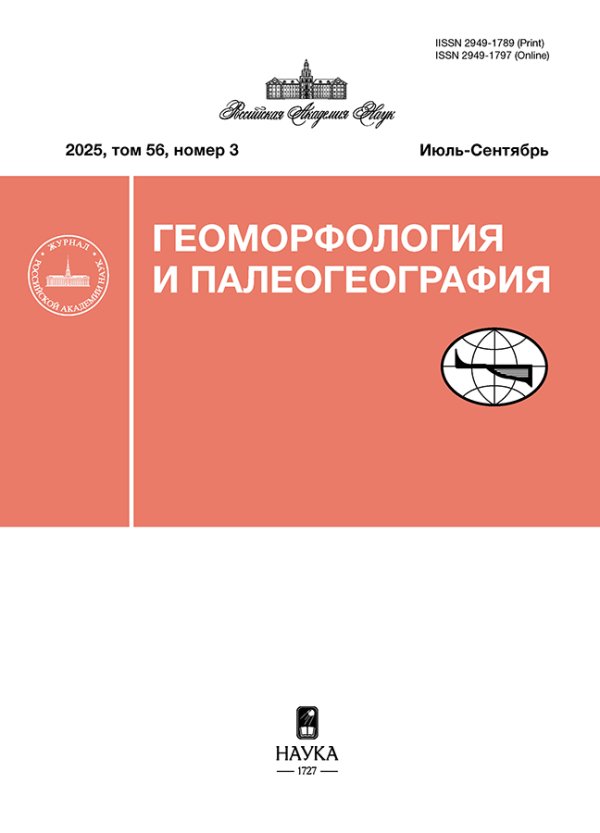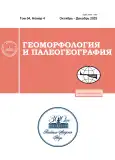DEVELOPMENT OF A REFERENCE TRANSECT BASED ON GPR DATA FOR WETLANDS IN THE SOUTHEASTERN PART OF THE ONEGA LOWLAND2
- Authors: Ryazantsev P.A.1, Ignashov P.A.2
-
Affiliations:
- Department of Multidisciplinary Scientific Research, Karelian Research Centre of RAS
- Institute of Biology, Karelian Research Centre of RAS
- Issue: Vol 54, No 4 (2023)
- Pages: 57-71
- Section: Paleolimnological research in Russia: from Kaliningrad to Kamchatka
- URL: https://journals.rcsi.science/2949-1789/article/view/232934
- DOI: https://doi.org/10.31857/S2949178923040096
- EDN: https://elibrary.ru/YCAWCP
- ID: 232934
Cite item
Full Text
Abstract
The post-glacial development of the Lake Onega coast, together with modern processes, creates conditions for the formation of complex coastal ecosystems that may be vulnerable to possible climate change and anthropogenic impacts. Such systems include wetlands extending along the eastern and southern coasts of Lake Onega. The area of a special interest is near the mouth of the Andoma River, as it combines the influence of the riverbed processes of a large river, the dynamics of the coast of Lake Onega, and peat lands development. The aim of the research was a detailed study of the structure of the Holocene deposits in the lake-river interval on the northern bank of the Andoma River, which reflects the stages of formation and variability of the natural conditions of the lakeside lowland. A reference transects including 4,800 m long GPR profile, supplemented with boreholes was created. The complex study of GPR cross-section and peat cores revealed the internal structure of the peat bog. A plateau-like uplift of the mineral base of the bog, framed by rupture zones with accompanying watercourses, was found. This area is considered as a deformation formed because of glacial dislocations or because of neotectonic deformations. Besides the main structural elements, local erosion incisions accompanied by sandy deposits, which could be confined to the buried paleochannels of the Andoma River, were found at the top of the limno-alluvial sediments. Analysis of the complex transect together with a vegetation description showed a difference in biological and environmental conditions zones, which contribute to biological diversity of the study site. In the future, the reference transects development provides a basis for the initial identification of vulnerabilities and long-term monitoring of the ecological transformation of ecosystems.
Keywords
About the authors
P. A. Ryazantsev
Department of Multidisciplinary Scientific Research, Karelian Research Centre of RAS
Author for correspondence.
Email: chthonian@yandex.ru
Russia, Petrozavodsk
P. A. Ignashov
Institute of Biology, Karelian Research Centre of RAS
Author for correspondence.
Email: paul.ignashov@gmail.com
Russia, Petrozavodsk
References
- Abramova T.G. (1965). Mires of the Vologda Region, their zoning and agricultural use. Severo-Zapad evropeiskoi chasti SSSR. Vol. 4. Leningrad: Leningrad University (Publ.). P. 65–93. (in Russ.).
- Bricheva S.S., Matasov V.M., Shilov P.M. (2017). Ground penetrating radar (GPR) as a part of integrated landscape studies on peatlands. Geoekologiya. Inzheneraya geologiya. Gidrogeologiya. Geokriologiya. No. 3. P. 76–83. (in Russ.).
- Buslovich A.L., Garkusha V.I., Nikolaev V.A. et al. (2021). Gosudarstvennaya geologicheskaya karta Rossiiskoi Fe-deratsii masshtaba 1:200000. Izdanie vtoroe. Seriya Onezh-skaya. List P-37-XXV. Vytegra. Ob"yasnitel’naya zapiska (State geological map of the Russian Federation, scale 1:200000. Second edition. Onega series. Sheet P-37-XXV. Vytegra. Explanatory letter). Moscow: VSEGEI. 124 p. (in Russ.). [Electronic data]. URL: http://geo.mfvsegei.ru/200k/Zap/Zap_P-37-XXV.pdf (access date: 31.03.2023)
- Carless D., Kulessa B., Booth A.D. et al. (2021). An integrated geophysical and GIS based approach improves estimation of peatland carbon stocks. Geoderma. Vol. 402. 115176. https://doi.org/10.1016/j.geoderma.2021.115176
- Chebotareva V.A. (2019). Late and post glacial sediments in the section of a low terraceon, the southwest coast of lake Onega. Trudy KarRC RAS. Vol. 10. No. 6 (1). P. 273–278. https://doi.org/10.25702/KSC.2307-5252.2019.6.040
- Comas X., Slater L., Reeve A. (2005). Stratigraphic controls on pool formation in a domed bog inferred from ground penetrating radar (GPR). J. Hydrol. Vol. 315. No. 1–4. P. 40–51. https://doi.org/10.1016/j.jhydrol.2005.04.020
- Comas X., Slater L., Reeve A.S. (2011). Pool patterning in a northern peatland: Geophysical evidence for the role of postglacial landforms. J. Hydrol. Vol. 399. No. 3–4. P. 173–184. https://doi.org/10.1016/j.jhydrol.2010.12.031
- Comas X., Terry N., Hribljan J.A. et al. (2017). Estimating belowground carbon stocks in peatlands of the Ecuadorian páramo using ground-penetrating radar (GPR). J. Geophys. Res.: Biogeosci. Vol. 122. No. 2. P. 370–386. https://doi.org/10.1002/2016JG003550
- Demidov I.N. (2006). O maksimal’noi stadii razvitiya Onezh-skogo prilednikovogo ozera, izmeneniyakh ego urovnya i glyatsioizostaticheskom podnyatii poberezhii v pozdnelednikov’e (On the maximum stage of development of the Onega periglacial lake, changes in its level and glacioisostatic uplift of the coasts in the late glacial period). Geology and Commercial Minerals of Karelia. Vol. 9. P. 171–182. (in Russ.).
- Engalychev S.Yu. (2007). Geological structure and genesis of dislocations on the Andoma Hills. Vestn. SPbGU. Ser. 7. Geologiya. Geografiya. No. 1. P. 32–39. (in Russ.).
- Filatov N., Baklagin V., Efremova T. et al. (2019). Climate change impacts on the watersheds of Lakes Onego and Ladoga from remote sensing and in situ data. Inland Waters. Vol. 9. No. 2. P. 130–141. https://doi.org/10.1080/20442041.2018.1533355
- Filonenko I.V., Philipov D.A. (2013). Estimation of the area of mires in the Vologda Region. Trudy Instorfa. No. 7. P. 3–11. (in Russ.).
- Hare D.K., Boutt D.F., Clement W.P. et al. (2017). Hydrogeological controls on spatial patterns of groundwater discharge in peatlands. Hydrol. Earth Syst. Sci. Vol. 21. No. 12. P. 6031–6048. https://doi.org/10.5194/hess-21-6031-2017
- Ignatov Е.I., Borshchenko E.V., Zagoskin A.L. et al. (2017). Connection between the geological structure of lake Onego region, its topographic evolution and the dynamics of the lake shores. Trudy KarRC RAS. No. 3. P. 65–78. (in Russ.). http://dx.doi.org/10.17076/lim514
- Ivanishcheva E.A. (2010). Ecological network of Vytegra district in Vologda Region. Izvestiya RAS SamSC. Vol. 12. No. 1(5). P. 1383–1386. (in Russ.).
- Ivanov A.O., Lukshevich E.V., Stinkulis G.V. et. al. (2003). Andoma Hill – a unique geological monument. Paleontologiya i prirodopol’zovanie. Tezisy dokladov XLIV sessii paleontologicheskogo ob-va. Saint Petersburg. P. 98–100. (in Russ.).
- Kaufman Z.S. (Ed.). (1990). Ekosistema Onezhskogo ozera i tendentsii ee izmeneniya (Ecosystem of Lake Onega and trends in its change). Leningrad: Nauka (Publ.). 264 p. (in Russ.)
- Kettridge N., Binley A., Comas X. et al. (2012). Do peatland microforms move through time? Examining the developmental history of a patterned peatland using ground-penetrating radar. J. Geophys. Res.: Biogeosci. Vol. 117. No. G3. G03030. https://doi.org/10.1029/2011JG001876
- Kolodyazhny S.Yu., Baluev A.S., Terekhov E.N. (2016). Andoma Segment of Southeastern Margin of Fennoscandian Shield: Structure and Evolution. Geotectonics. No. 4. P. 48–67. (in Russ.). https://doi.org/10.7868/S0016853X16040056
- Kutenkov S.A. (2013). Korpi software for plotting stratigraphic diagrams of peat composition. Trudy KarRC RAS. No. 6. P. 171–176. (in Russ.).
- Leopold M., Völkel J. (2003). GPR images of periglacial slope deposits beneath peat bogs in the Central European Highlands, Germany. Geological Society, London, Special Publications. Vol. 211. No. 1. P. 181–189. https://doi.org/10.1144/GSL.SP.2001.211.01.1
- Loisel J., Yu Z., Parsekian A., Nolan J. et al. (2013). Quantifying landscape morphology influence on peatland lateral expansion using ground-penetrating radar (GPR) and peat core analysis. J. Geophys. Res.: Biogeosci. Vol. 118. No. 2. P. 373–384. https://doi.org/10.1002/jgrg.20029
- Neal A. (2004). Ground-penetrating radar and its use in sedimentology: principles, problems and progress. Earth-Sci. Rev. Vol. 66. No. 3–4. P. 261–330. https://doi.org/10.1016/j.earscirev.2004.01.004
- Parsekian A.D., Slater L., Ntarlagiannis D. et al. (2012). Uncertainty in peat volume and soil carbon estimated using ground-penetrating radar and probing. Soil Sci. Soc. Am. J. Vol. 76. No. 5. P. 1911–1918. https://doi.org/10.2136/sssaj2012.0040
- Pezdir V., Čeru T., Horn B. et al. (2021). Investigating peatland stratigraphy and development of the Šijec bog (Slovenia) using near-surface geophysical methods. Catena. Vol. 206. 105484. https://doi.org/10.1016/j.catena.2021.105484
- Philipov D.A. (2008). Struktura i dinamika ekosistem poimennykh bolot basseina Onezhskogo ozera (Vologodskaya oblast’) (Structure and dynamics of ecosystems of floodplain mires of the Lake Onega basin (Vologda Region)). PhD thesis. Vologda. 219 p. (in Russ.).
- Proulx-McInnis S., St-Hilaire A., Rousseau A.N. et al. (2013). A review of ground-penetrating radar studies related to peatland stratigraphy with a case study on the determination of peat thickness in a northern boreal fen in Quebec, Canada. Progress in Physical Geography. Vol. 37. No. 6. P. 767–786. https://doi.org/10.1177/0309133313501106
- Ryazantsev P.A., Ignashov P.A. (2019). Ground Penetrating Radar measurements of bog deposits (a case study of the Zaonezhskii Peninsula, Karelia). Geogr. Nat. Res. No. 4. P. 125–134. (in Russ.). https://doi.org/10.21782/GIPR0206-1619-2019-4(125-134)
- Sass O., Friedmann A., Haselwanter G. et al. (2010). Investigating thickness and internal structure of alpine mires using conventional and geophysical techniques. Catena. Vol. 80. No. 3. P. 195–203. https://doi.org/10.1016/j.catena.2009.11.006
- Shvarev S.V., Nikonov A.A. (2022). The influence of strong earthquakes on the relief, sediments and hydrodynamics of the Lake Onega region. Subetto D.A. (Ed.). Paleolimnologiya Onezhskogo ozera: ot prilednikovogo ozera k sovremennym usloviyam. Petrozavodsk: KarRC RAS (Publ.). P. 218–231. (in Russ.).
- Shennikov A.P. (1964). Vvedenie v geobotaniku (Introduction to geobotany). Leningrad: Leningrad University (Publ.). 447 p. (in Russ.).
- Subetto D.A. (Ed.). (2022). Paleolimnologiya Onezhsko-go ozera: ot prilednikovogo ozera k sovremennym usloviyam (Paleolimnology of Lake Onega: from the periglacial lake to modern conditions). Petrozavodsk: KarRC RAS (Publ.). 333 p. (in Russ.).
- Trappe J., Kneisel C. (2019). Geophysical and sedimentological investigations of peatlands for the assessment of lithology and subsurface water pathways. Geosciences. Vol. 9. No. 3. 118. https://doi.org/10.3390/geosciences9030118
- Vladov M.L., Starovojtov A.V. (2004). Vvedenie v georadiolokatsiyu (Introduction to GPR). Moscow: MSU (Publ.). 153 p. (in Russ.).
- Walter J., Hamann G., Lück E. et al. (2016). Stratigraphy and soil properties of fens: Geophysical case studies from northeastern Germany. Catena. Vol. 142. P. 112–125. https://doi.org/10.1016/j.catena.2016.02.028
- Zobkov M., Potakhin M., Subetto A. et al. (2019). Reconstructing Lake Onego evolution during and after the Late Weichselian glaciation with special reference to water volume and area estimations. J. Paleolimnol. Vol. 62 (1). P. 53–71. https://doi.org/10.1007/s10933-019-00075-3
Supplementary files

















